Video: ‘World’s greenest building’ to welcome students


With solar panels to heat up water, rain captured to flush the toilets and a screen in the kitchens showing how much power is being used, Bradford University’s new £40m student village has been named as a global leader.
The Green, which was launched yesterday on the edge of the city centre on the university’s main campus, is one of only 15 developments across the world to be ranked as outstanding by an international system measuring environmental building standards.
Advertisement
Hide AdAdvertisement
Hide AdMore than a million buildings around the world have been assessed by BREEAM (Building Research Establishment Environmental Assessment) since it was created two decades ago – but nothing has ever been given a higher score than Bradford University’s new student village.


The Green consists of more than 1,000 bedrooms in either four-storey townhouses or six- and seven-storey blocks of flats around a central pond which is used to collect rainwater.
Rain which lands on the roof is also collected and used to help flush toilets, while solar panels reduce the energy cost of providing hot water and extra insulation to ensure the development has minimal heating costs.
The development has been built with a timber frame and has a “heat ventilation recovery system” which ensures stale air is replaced without a room losing any heat. The building is also able to capture heat from an electricity generator to help warm the rooms while large windows have been designed to let in natural light without creating “excess heat” from the sun.
Advertisement
Hide AdAdvertisement
Hide AdIt is not only the building’s design which is sustainable, students will also be encouraged to play their part.
Everyone moving into The Green will be given a user’s manual and the flats will contain monitors which show students how much energy they have used in a week.
Chris Guyatt, from Leeds-based GWP architects, said: “One of things we have noticed with other university developments is that students like to be competitive. Each townhouse will have its own display showing how much energy has been used in a week and how much they used the week before. It will also show which house in The Green used the least energy.”
The kitchens will include recycling and composting facilities and students will also be encouraged to grow their own vegetables. Students will begin moving into The Green next week with priority given to first years starting university. The idea of a sustainable student village was launched in 2005 when Bradford University unveiled its “Ecoversity” programme.
Advertisement
Hide AdAdvertisement
Hide AdThe development is also part of a vision to create a “learning quarter” in Bradford around the city’s college and university campus which could attract up to £750m investment over 10 years. The next phase of the learning quarter, known as the Listerhills Triangle, is already under way.
It is set to include student accommodation and also attract occupiers from the retail, health, fitness and private nursery sector. The combined investment in The Green and the Listerhills Triangle is set to exceed £100m and transform an area in need of regeneration.
Bradford University’s vice-chancellor, Prof Mark Cleary, said: “We are delighted that the latest phase in our campus development programme has delivered the most sustainable building in the world in terms of both construction and design. The Green will be a place where our students can learn to live in a way that minimises negative environmental impact without compromising on quality of life or experience.”
Mohammed Ishtiaq, the managing director of Mi7 developments which managed the scheme, said: “The final delivery of the Green represents the culmination of an eight-year journey that began with a vision to create a new concept in student living that would set a precedent for future developments worldwide.”
The Green has been developed by Mi7 Developments and funded by Welbeck Land, the Hayaat Group, the university and Yorkshire Forward.